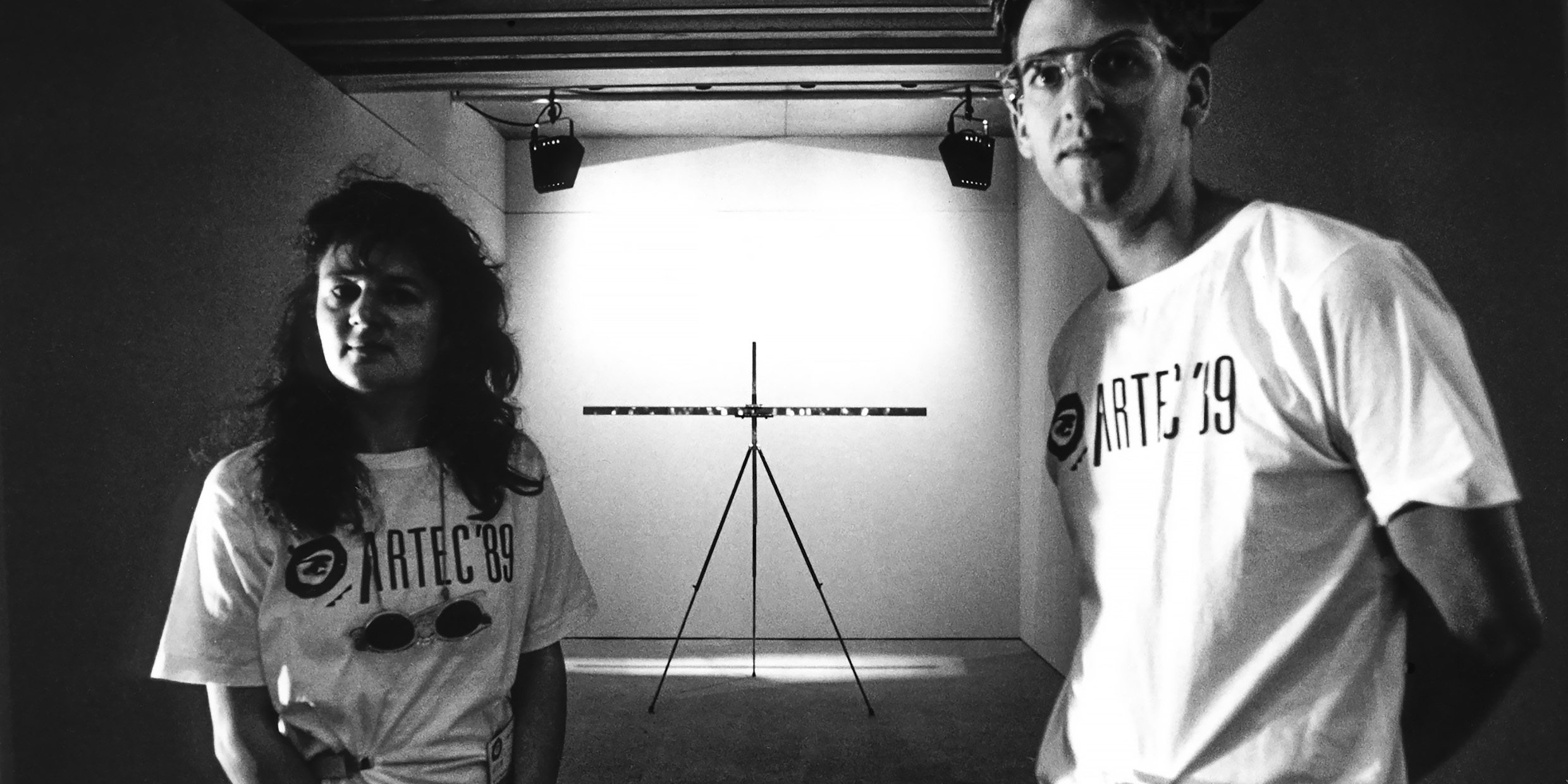Originally published 20 October 1997
Michael Wenyon, with his collaborator Susan Gamble, is an artist-in-residence at MIT’s Haystack Radio Observatory in Westford, a place dotted with huge dish antennas that eavesdrop on radio frequency radiation washing through space.
Artist-in-residence? At a bastion of science?
It may sound strange, but it’s not a first.
In 1987, Wenyon and Gamble were artists-in-residence at the Royal Greenwich Observatory at Herstmonceux Castle in England. Before coming to Massachusetts, they also spent time as artists-in- residence at The Royal Observatory at Edinburgh.
One of their installations is currently on display in an exhibit called “The Physics of Art” at Brockton’s Fuller Art Museum, a colorful creation called Optical Experiments, 1994/96, incorporating holograms and historic astronomical photographic plates and mirrors.
The catalog introduction to a 1991 Wenyon and Gamble exhibit at the Wolverhampton Art Gallery in England says this of their work: “Wenyon and Gamble’s holograms have a cool alien beauty like objects from another world. They stand on their delicate tripods; windows into zones of shifting spectrum color. In some, an everyday object hangs in a boiling furnace of color, in others we glimpse the endless voids of deep space.”
As artists-in-residence, Wenyon and Gamble are not PR reps for their institutions, nor should they be. Their work is independent, personal, and visionary. Yet, at their host institutions, they are close observers, willing, if necessary, to master new technologies. They are transformers of esoteric science into human-tempered beauty.
The idea of artists-in-residence at scientific research institutions strikes me as exceptionally useful. God knows, as a society we are alienated enough from science. Our tax dollars support basic scientific research to the tune of $16.5 billion a year, but most of us have only the vaguest notion of what the money is spent on — or why it is worth spending.
Consider, for example, just one artifact from the multi-billion dollar Hubble Space Telescope — the Hubble Deep-Field Photograph.
This remarkable image is the deepest we have ever seen into the universe. It shows a tiny part of the sky that could be covered by crossed pins held at arm’s length; it would require 40,000 such photographs to cover the bowl of the Big Dipper. The total exposure time was 10 days.
In the photo, we see fainter and more distant objects than ever before. In this pin-prick patch of sky we see several thousand galaxies, galaxies as numerous as snowflakes in a storm. Every galaxy contains hundreds of billions of stars, each, perhaps, with planets. If we surveyed the entire sky at the scale of the Hubble Deep-Field Photograph, we would see 100 billion galaxies, receding into infinity — worlds and worlds without end.
This image flashed briefly on the screens of our televisions and in the pages of our magazines and newspapers. We nodded. We said “Wow!” Then we put the remarkable image out of our minds. We don’t give a thought to what it might mean to live in a universe of 100 billion galaxies. We prefer a cozier, human-centered universe, constructed on the human scale.
In the same way, we give only passing notice to other scientific research that has the potential to transform the way we think of ourselves and the world we live in: the sequencing of the human genome; the intersection of neurobiology, evolutionary theory, artificial intelligence, and computational theory; experimental quantum physics and the theory of non-locality; planetary exploration; X‑ray, gamma ray, and infrared astronomy; the deep- ocean drilling program.
We are vaguely interested in these developments, but we haven’t a clue how they touch our lives at the level of our emotional, esthetic, and erotic lives. We need artists who will go into the environs of research, and return with disturbing works of art that shake us out of our intellectual sloth and help us to see the world in fresh new ways.
In an often quoted passage, novelist and essayist Arthur Koestler wrote, “Einstein’s space is no closer to reality than Van Gogh’s sky. The glory of science is not a truth more absolute than the truth of Bach or Tolstoy… The scientist’s discoveries impose his own order on chaos, as the composer or painter imposes his; an order that always refers to limited aspects of reality.”
Einstein’s space is certainly closer to the world “out there” than is Van Gogh’s sky. But Van Gogh’s sky is closer to our inner world. We must find ways to make these two worlds, these two visions of reality, mutually reinforcing. Artist-in-residence programs at scientific research institutions can help.
Every research institution supported by more than $10 million of federal funds should be required to have an artist-in-residence. Scientists and artists need to brush shoulders, learn from each other, pass vibes back and forth, look for the places where quarks and quasars touch the longings and passions of the human heart.
Scientists may protest that mandated artist-in-residence programs will divert funds that might better be used for basic science. But unless we find creative ways to connect basic scientific research to the human-centered world of Van Gogh’s sky, the public will continue to withdraw their support from science, and scientists may find themselves living in the laboratory equivalent of the starving artist’s garret.
More of the work of Wenyon & Gamble can be found at their website. ‑Ed.



